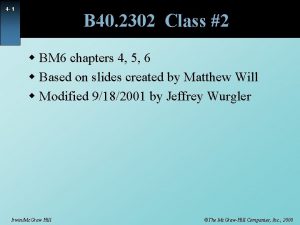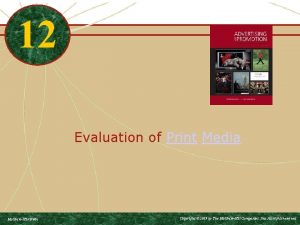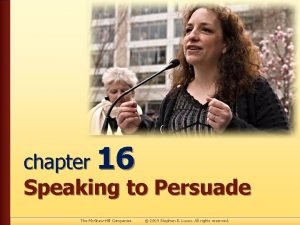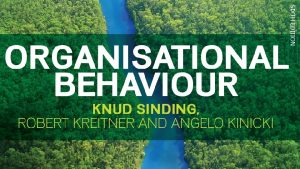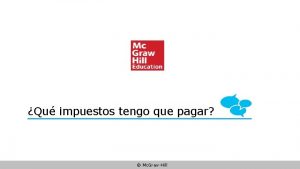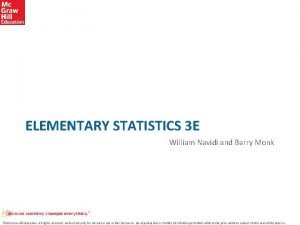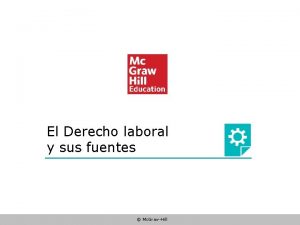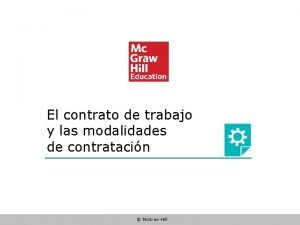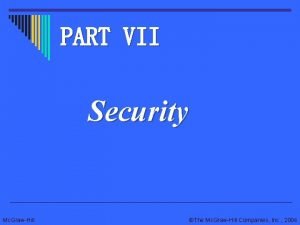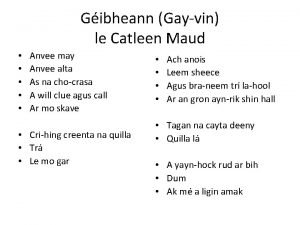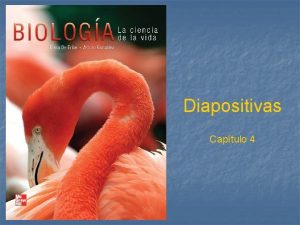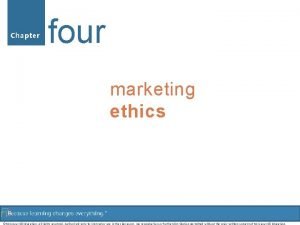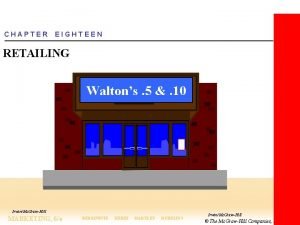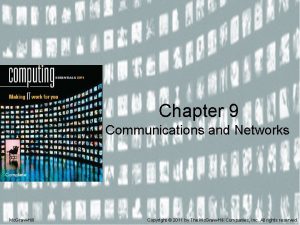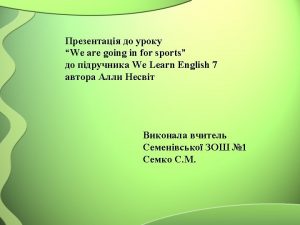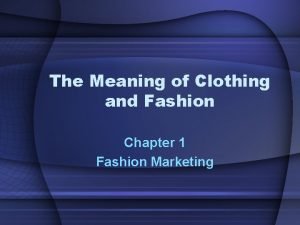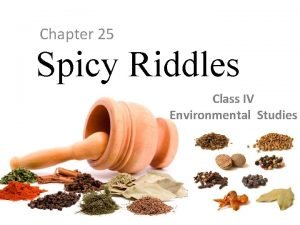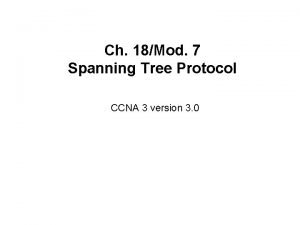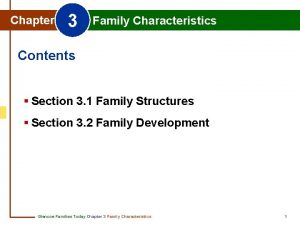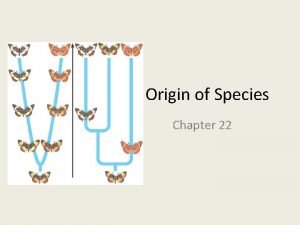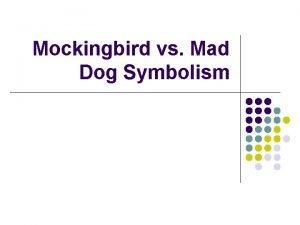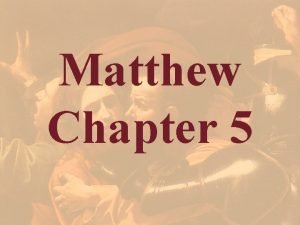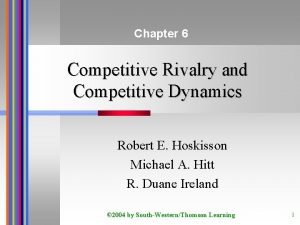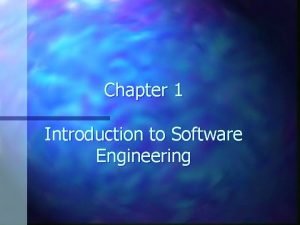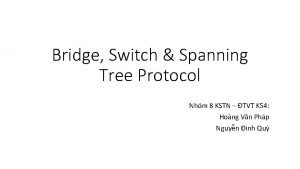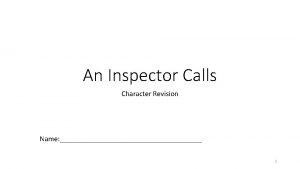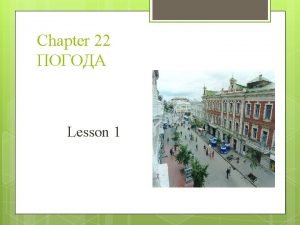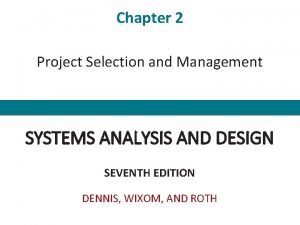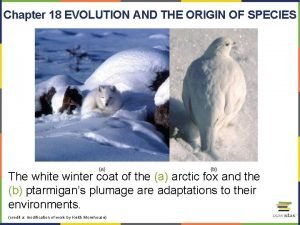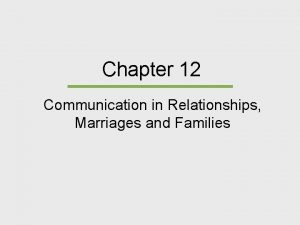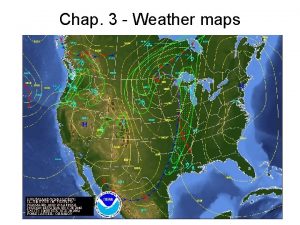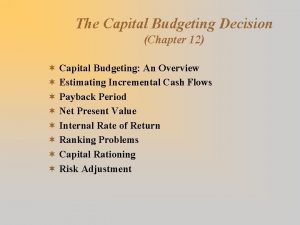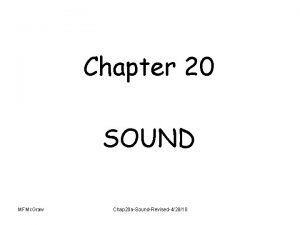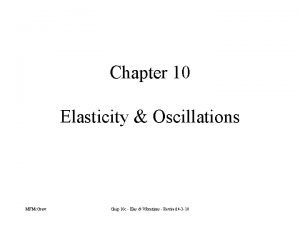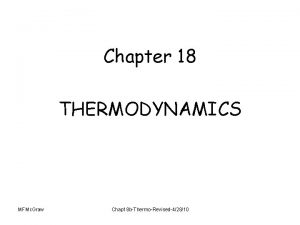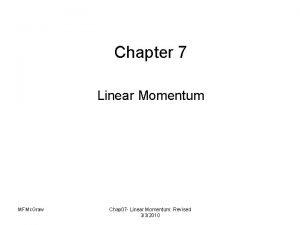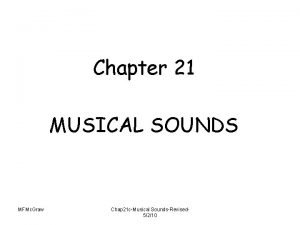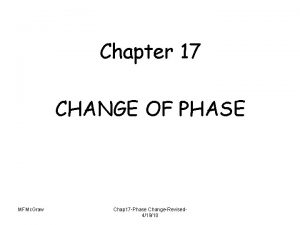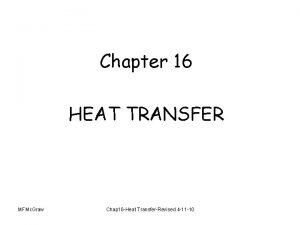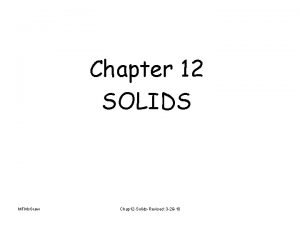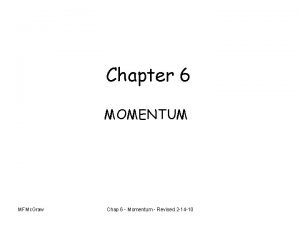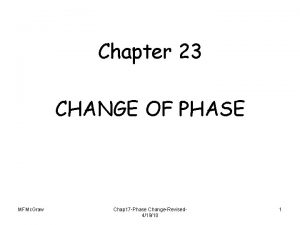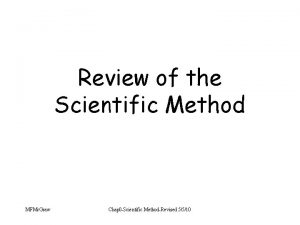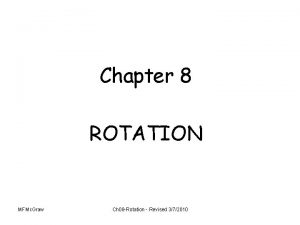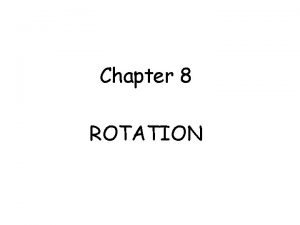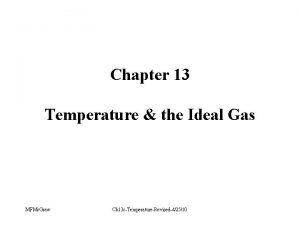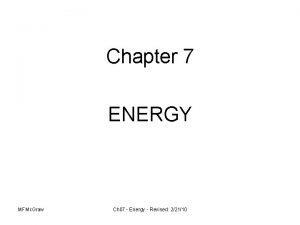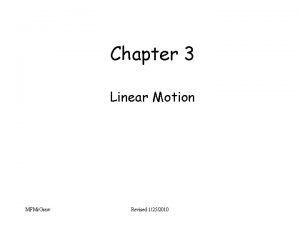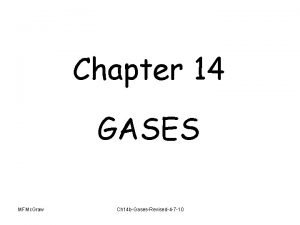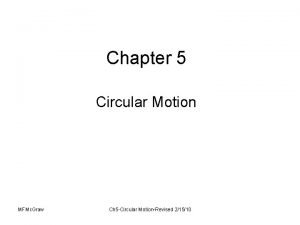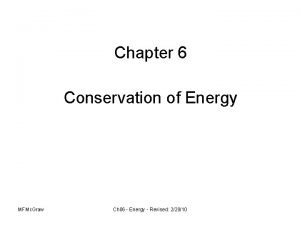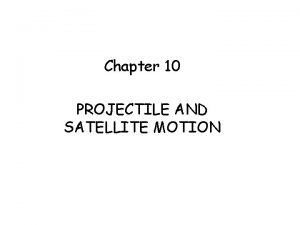Chapter 20 SOUND MFMc Graw Chap 20 aSoundRevised42810




















































- Slides: 52

Chapter 20 SOUND MFMc. Graw Chap 20 a-Sound-Revised-4/28/10

This lecture will help you understand: • • • MFMc. Graw Nature of Sound Origin of Sound in Air Media That Transmit Sound Speed of Sound in Air Reflection of Sound Refraction of Sound Forced Vibrations Natural Frequency Resonance Interference Beats Chap 20 a-Sound-Revised-4/28/10

Nature of Sound is a form of energy that exists whether or not it is heard. Do you agree? MFMc. Graw Chap 20 a-Sound-Revised-4/28/10

Origin of Sound Most sounds are waves produced by the vibrations of matter. For example: • In a piano, a violin, and a guitar, the sound is produced by the vibrating strings; • in a saxophone, by a vibrating reed; • in a flute, by a fluttering column of air at the mouthpiece; • in your voice due to the vibration of your vocal chords. MFMc. Graw Chap 20 a-Sound-Revised-4/28/10

Origin of Sound • The original vibration stimulates the vibration of something larger or more massive, such as – the sounding board of a stringed instrument, – the air column within a reed or wind instrument, or – the air in the throat and mouth of a singer. • This vibrating material then sends a disturbance through the surrounding medium, usually air, in the form of longitudinal sound waves. MFMc. Graw Chap 20 a-Sound-Revised-4/28/10

Origin of Sound • Under ordinary conditions, the frequencies of the vibrating source and sound waves are the same. • The subjective impression about the frequency of sound is called pitch. • The ear of a young person can normally hear pitches corresponding to the range of frequencies between about 20 and 20, 000 Hertz. • As we grow older, the limits of this human hearing range shrink, especially at the highfrequency end. MFMc. Graw Chap 20 a-Sound-Revised-4/28/10

Origin of Sound • Sound waves with frequencies below 20 hertz are infrasonic (frequency too low for human hearing). • Sound waves with frequencies above 20, 000 hertz are called ultrasonic (frequency too high for human hearing). • We cannot hear infrasonic and ultrasonic sound. MFMc. Graw Chap 20 a-Sound-Revised-4/28/10

Sound in Air Sound waves • are vibrations made of compressions and rarefactions. • are longitudinal waves. • require a medium. • travel through solids, liquids, and gases. MFMc. Graw Chap 20 a-Sound-Revised-4/28/10

Sound in Air Wavelength of sound • Distance between successive compressions or rarefactions MFMc. Graw Chap 20 a-Sound-Revised-4/28/10

Sound in Air How sound is heard from a radio loudspeaker • Radio loudspeaker is a paper cone that vibrates. • Air molecules next to the loudspeaker set into vibration. • Produces compressions and rarefactions traveling in air. • Sound waves reach your ears, setting your eardrums into vibration. • Sound is heard. MFMc. Graw Chap 20 a-Sound-Revised-4/28/10

Media That Transmit Sound • Any elastic substance — solid, liquid, gas, or plasma — can transmit sound. • In elastic liquids and solids, the atoms are relatively close together, respond quickly to one another’s motions, and transmit energy with little loss. • Sound travels about 4 times faster in water than in air and about 15 times faster in steel than in air. MFMc. Graw Chap 20 a-Sound-Revised-4/28/10

Speed of Sound in Air Speed of sound • Depends on wind conditions, temperature, humidity – Speed in dry air at 0 C is about 330 m/s. – In water vapor slightly faster. – In warm air faster than cold air. • Each degree rise in temperature above 0 C, speed of sound in air increases by 0. 6 m/s • Speed in water about 4 times speed in air. • Speed in steel about 15 times its speed in air. MFMc. Graw Chap 20 a-Sound-Revised-4/28/10

Speed of Sound in Air CHECK YOUR NEIGHBOR You watch a person chopping wood and note that after the last chop you hear it 1 second later. How far away is the chopper? • • 330 m More than 330 m Less than 330 m There’s no way to tell. MFMc. Graw Chap 20 a-Sound-Revised-4/28/10

Speed of Sound in Air CHECK YOUR ANSWER You watch a person chopping wood and note that after the last chop you hear it 1 second later. How far away is the chopper? • • 330 m More than 330 m Less than 330 m There’s no way to tell. MFMc. Graw Chap 20 a-Sound-Revised-4/28/10

Speed of Sound in Air CHECK YOUR NEIGHBOR You hear thunder 2 seconds after you see a lightning flash. How far away is the lightning? • • 340 m/s 660 m/s More than 660 m/s There’s no way to tell. MFMc. Graw Chap 20 a-Sound-Revised-4/28/10

Speed of Sound in Air CHECK YOUR ANSWER You hear thunder 2 seconds after you see a lightning flash. How far away is the lightning? • • 340 m/s 660 m/s More than 660 m/s There’s no way to tell. MFMc. Graw Chap 20 a-Sound-Revised-4/28/10

Reflection of Sound Reflection • Process in which sound encountering a surface is returned • Often called an echo • Multiple reflections— called reverberations MFMc. Graw Chap 20 a-Sound-Revised-4/28/10

Reflection of Sound CHECK YOUR NEIGHBOR Reverberations are best heard when you sing in a room with • • carpeted walls. hard-surfaced walls. open windows. None of the above. MFMc. Graw Chap 20 a-Sound-Revised-4/28/10

Reflection of Sound CHECK YOUR ANSWER Reverberations are best heard when you sing in a room with • • carpeted walls. hard-surfaced walls. open windows. None of the above. Explanation: Rigid walls better reflect sound energy. Fabric is absorbent, and open windows let sound energy escape from the room. MFMc. Graw Chap 20 a-Sound-Revised-4/28/10

Reflection of Sound A situation to ponder… Consider a person attending a concert that is being broadcast over the radio. The person sits about 45 m from the stage and listens to the radio broadcast with a transistor radio over one ear and a nonbroadcast sound signal with the other ear. Further suppose that the radio signal must travel all the way around the world before reaching the ear. MFMc. Graw Chap 20 a-Sound-Revised-4/28/10

A situation to ponder… CHECK YOUR NEIGHBOR Which signal will be heard first? • • Radio signal Nonbroadcast sound signal Both at the same time. None of the above. MFMc. Graw Chap 20 a-Sound-Revised-4/28/10

A situation to ponder… CHECK YOUR ANSWER Which signal will be heard first? • • Radio signal Nonbroadcast sound signal Both at the same time. None of the above. Explanation: A radio signal travels at the speed of light, 3 108 m/s. Time to travel 45 m at 340 m/s ≈ 0. 13 s. Time to travel 4 107 m (Earth’s circumference) at 3 108 m/s ≈ 0. 13 s. Therefore, if you sit farther back at the concert, the radio signal would reach you first! MFMc. Graw Chap 20 a-Sound-Revised-4/28/10

Reflection of Sound Acoustics • Study of sound Example: A concert hall aims for a balance between reverberation and absorption. Some have reflectors to direct sound (which also reflect light— so what you see is what you hear). MFMc. Graw Chap 20 a-Sound-Revised-4/28/10

Refraction of Sound Refraction • Bending of waves—caused by changes in speed affected by – wind variations. – temperature variations. MFMc. Graw Chap 20 a-Sound-Revised-4/28/10

Refraction of Sound CHECK YOUR NEIGHBOR When air near the ground on a warm day is warmed more than the air above, sound tends to bend • • upward. downward. at right angles to the ground. None of the above. MFMc. Graw Chap 20 a-Sound-Revised-4/28/10

Refraction of Sound CHECK YOUR ANSWER When air near the ground on a warm day is warmed more than the air above, sound tends to bend • • upward. downward. at right angles to the ground. None of the above. MFMc. Graw Chap 20 a-Sound-Revised-4/28/10

Refraction of Sound CHECK YOUR NEIGHBOR In the evening, when air directly above a pond is cooler than air above, sound across a pond tends to bend • • upward. downward. at right angles to the ground. None of the above. MFMc. Graw Chap 20 a-Sound-Revised-4/28/10

Refraction of Sound CHECK YOUR ANSWER In the evening, when air directly above a pond is cooler than air above, sound across a pond tends to bend • • upward. downward. at right angles to the ground. None of the above. Explanation: This is why sound from across a lake at night is easily heard. MFMc. Graw Chap 20 a-Sound-Revised-4/28/10

Reflection and Refraction of Sound Multiple reflection and refractions of ultrasonic waves • Device sends high-frequency sounds into the body and reflects the waves more strongly from the exterior of the organs, producing an image of the organs. • Used instead of X-rays by physicians to see the interior of the body. MFMc. Graw Chap 20 a-Sound-Revised-4/28/10

Early Ultrasonic Application Sound Waves get your wash clean, claims Robert Bosch of Stuttgart, Germany. This seven-pound machine works on principle of auto horn. Hooter must sound for five minutes. Cost is $32. MFMc. Graw Chap 20 a-Sound-Revised-4/28/10

Ultrasonic Food Washer removes 98% of Bacteria! MFMc. Graw Chap 20 a-Sound-Revised-4/28/10

Reflection and Refraction of Sound Dolphins emit ultrasonic waves to enable them to locate objects in their environment. MFMc. Graw Chap 20 a-Sound-Revised-4/28/10

Forced Vibrations Forced vibration • Setting up of vibrations in an object by a vibrating force Example: factory floor vibration caused by running of heavy machinery MFMc. Graw Chap 20 a-Sound-Revised-4/28/10

Natural Frequency Natural frequency • Own unique frequency (or set of frequencies) • Dependent on – elasticity – shape of object MFMc. Graw Chap 20 a-Sound-Revised-4/28/10

Resonance A phenomenon in which the frequency of forced vibrations on an object matches the object’s natural frequency Examples: • Swinging in rhythm with the natural frequency of a swing • Tuning a radio station to the “carrier frequency” of the radio station • Troops marching in rhythm with the natural frequency of a bridge (a no-no!) MFMc. Graw Chap 20 a-Sound-Revised-4/28/10

Resonance Dramatic example of wind-generated resonance MFMc. Graw Chap 20 a-Sound-Revised-4/28/10

Resonance Tacoma Narrows Bridge Nov. 7, 1940 MFMc. Graw Chap 20 a-Sound-Revised-4/28/10

Tacoma Narrows Bridge The first Tacoma Narrows Bridge opened to traffic on July 1, 1940. It collapsed four months later on November 7, 1940, at 11: 00 AM (Pacific time) due to a physical phenomenon known as aeroelastic flutter caused by a 67 kilometres per hour (42 mph) wind. The bridge collapse had lasting effects on science and engineering. In many undergraduate physics texts the event is presented as an example of elementary forced resonance with the wind providing an external periodic frequency that matched the natural structural frequency (even though the real cause of the bridge's failure was aeroelastic flutter). Its failure also boosted research in the field of bridge aerodynamics/ aeroelastics which have themselves influenced the designs of all the world's great long-span bridges built since 1940. - Wikipedia http: //www. youtube. com/watch? v=3 mclp 9 Qm. CGs - Best w/sound http: //www. youtube. com/watch? v=Ce-PQqk. IXe 0&feature=related - Car only http: //www. youtube. com/watch? v=P 0 Fi 1 Vcbp. AI&feature=related - People on moving bridge MFMc. Graw Chap 20 a-Sound-Revised-4/28/10

Interference • Property of all waves and wave motion • Superposition of waves that may either reinforce or cancel each other MFMc. Graw Chap 20 a-Sound-Revised-4/28/10

Interference CHECK YOUR NEIGHBOR Interference is a property of • • sound. light. Both of the above. Neither of the above. MFMc. Graw Chap 20 a-Sound-Revised-4/28/10

Interference CHECK YOUR ANSWER Interference is a property of • • sound. light. Both of the above. Neither of the above. Explanation: See Figure 12. 21 for illustrations of both light and sound interference. Interestingly, the presence of interference tells a physicist whether something is wavelike. All types of waves can interfere. MFMc. Graw Chap 20 a-Sound-Revised-4/28/10

Interference Two patterns of interference • Constructive interference – increased amplitude when the crest of one wave overlaps the crest of another wave • Destructive interference – reduced amplitude when the crest of one wave overlaps the trough of another wave MFMc. Graw Chap 20 a-Sound-Revised-4/28/10

Interference MFMc. Graw Chap 20 a-Sound-Revised-4/28/10

Interference Application of sound interference • Destructive sound interference in noisy devices such as jackhammers that are equipped with microphones to produce mirror-image wave patterns fed to operator’s earphone, canceling the jackhammer’s sound MFMc. Graw Chap 20 a-Sound-Revised-4/28/10

Interference Application of sound interference (continued) • Sound interference in stereo speakers out of phase sending a monoaural signal (one speaker sending compressions of sound and other sending rarefactions) • As speakers are brought closer to each other, sound is diminished. MFMc. Graw Chap 20 a-Sound-Revised-4/28/10

Beats • Periodic variations in the loudness of sound due to interference • Occur with any kind of wave • Provide a comparison of frequencies MFMc. Graw Chap 20 a-Sound-Revised-4/28/10

Beat Frequency Example By placing a small piece of putty on one of the tuning forks the increased mass causes its frequency to decrease slightly. MFMc. Graw Chap 20 a-Sound-Revised-4/28/10

Beat Frequency MFMc. Graw Chap 20 a-Sound-Revised-4/28/10

Beat Frequency Two waves of different frequency Superposition of the above waves The beat frequency is MFMc. Graw Chap 20 a-Sound-Revised-4/28/10

Physical Example of the Beat Phenomena MFMc. Graw Chap 20 a-Sound-Revised-4/28/10

Beats • Applications – Piano tuning by listening to the disappearance of beats from a tuning fork and a piano key – Tuning instruments in an orchestra by listening for beats between instruments and piano tone MFMc. Graw Chap 20 a-Sound-Revised-4/28/10

Summary • • • MFMc. Graw Nature of Sound Origin of Sound in Air Media That Transmit Sound Speed of Sound in Air Reflection of Sound Refraction of Sound Forced Vibrations Natural Frequency Resonance Interference Beats Chap 20 a-Sound-Revised-4/28/10
 Chap chap slide
Chap chap slide What is flaw graw
What is flaw graw Operations definition
Operations definition Freshwater ecosystems are classified as
Freshwater ecosystems are classified as Evaluation of print media
Evaluation of print media Mc-graw hill
Mc-graw hill Suzanne graw
Suzanne graw Mc graw hill education
Mc graw hill education Mc graw hill education
Mc graw hill education Area principle statistics
Area principle statistics Mc graw hill education
Mc graw hill education Mc graw hill education
Mc graw hill education Mc graw hill
Mc graw hill Gonall
Gonall Mc graw hill
Mc graw hill Flaw graw
Flaw graw Retail positioning matrix
Retail positioning matrix Define graw
Define graw Graw outlet
Graw outlet “a sound mind is in a sound body”
“a sound mind is in a sound body” Sound waves graphic organizer
Sound waves graphic organizer 패션 chap 1
패션 chap 1 Passion chap 6
Passion chap 6 Bank run chap 11
Bank run chap 11 Autocorrelation ppt gujarati
Autocorrelation ppt gujarati Spicy riddles
Spicy riddles Kstn chap 18
Kstn chap 18 Family values chapter 3
Family values chapter 3 The origin of species manhwa chapter 24
The origin of species manhwa chapter 24 Satisfying needs 1
Satisfying needs 1 The origin of species chapter 22 bl
The origin of species chapter 22 bl Mad dog ch 25
Mad dog ch 25 What are the 5 major discourses in matthew
What are the 5 major discourses in matthew Child development chapter 1
Child development chapter 1 Rivalry ch 6
Rivalry ch 6 System engineer chap 1
System engineer chap 1 Chap tree
Chap tree Tree switch
Tree switch I was in that state when a chap easily turns nasty analysis
I was in that state when a chap easily turns nasty analysis The origin of species chapter 24 bl
The origin of species chapter 24 bl Passion chap 9
Passion chap 9 đường bao của mặt cắt chập được vẽ bằng
đường bao của mặt cắt chập được vẽ bằng In the summer chap 22
In the summer chap 22 Selection project 2
Selection project 2 The origin of species - chapter 18 bl
The origin of species - chapter 18 bl The emotional bonding of family members is referred to as
The emotional bonding of family members is referred to as Fitness - chapter 1
Fitness - chapter 1 Chap tree
Chap tree Chap 3 map
Chap 3 map Chap 23
Chap 23 Payback chap 12
Payback chap 12 Fitness chapter 1
Fitness chapter 1 Swapping chap 21
Swapping chap 21

